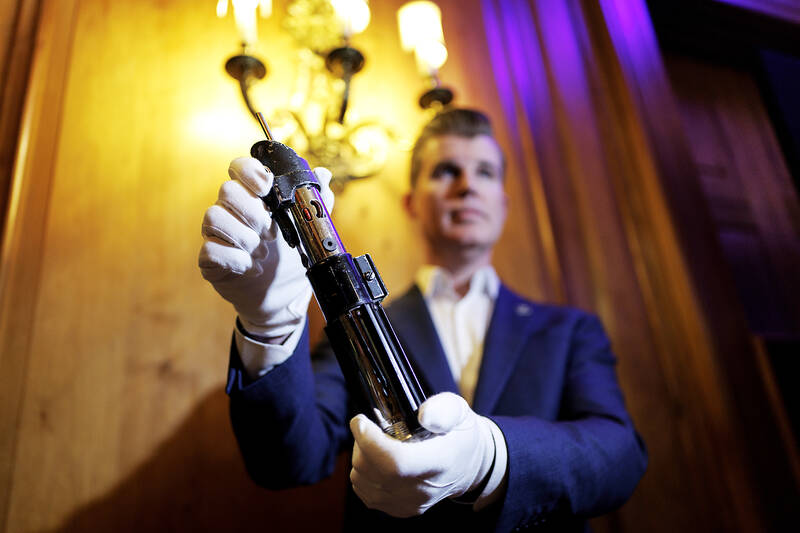Iconic movie props from a galaxy far, far away, and from a search for the Holy Grail much closer to home, are for sale in a blockbuster auction in California featuring a trove of silver screen history.
Darth Vader’s lightsaber from the final two films of the original Star Wars trilogy is the most valuable lot in the three-day online auction hosted by Propstore, a Los Angeles company specializing in movie memorabilia.
The weapon, wielded to devastating effect by Vader, the Dark Lord of the Sith, in the films The Empire Strikes Back (1980) and Return of the Jedi (1983), is valued at up to US$3 million. It is worn and has several dings and imperfections, which Propstore said enhances its authenticity and value.

Photo: EPA
The company said it is believed to be “the only hero lightsaber prop with verifiable screen-use to ever be offered at public auction” and “one of the rarest and most sought after Star Wars props in existence”.
A host of other artifacts from a range of action, adventure and science fiction movies make up the rest of the more than 1,000 lots in the three-day sale that ends today.
Among them are the leather whip brandished by actor Harrison Ford in the 1989 movie Indiana Jones and the Last Crusade as he battled Nazis in a quest for the Holy Grail (estimated value US$500,000); and the electro biomechanical neural transmitting zero-synapse repositioner known as a neuralyzer, used by alien hunters Will Smith and Tommy Lee Jones to erase people’s memories in the 1997 fantasy tale Men in Black (US$150,000).
For movie buffs not into handheld props, Jane Fonda’s figure hugging catsuit from the 1968 movie Barbarella is valued at up to US$10,000, as is a brown leather suit of armor from the Black Queen’s Black Guard in the same movie.
“Collecting is a very personal thing as all collectors have different tastes, but collectors are united through a common passion for the material and its preservation,” Propstore says in its auction brochure.
“Throughout the entertainment industry’s history these items were considered as mere production tools and were therefore commonly discarded. Private collectors stepped in and took preservation into their own hands.
“Some artifact collecting stories are legendary: a college student walking through a field and stumbling on the model miniature space station from 2001: A Space Odyssey after the item was dumped.”
Many of the items for sale reach into the genre of science fiction. There are space suits, laser weapons, posters of spaceships and body armor from movies including Alien, Armageddon and Back to the Future.
Costumes also feature heavily, including Michael Keaton’s Batman suit from the 1989 movie of the same name, valued at US$500,000; a Roman soldier’s outfit from the 1959 classic Ben-Hur; and Jeff Bridges’ “bowling and nihilistic confrontation costume” worn as he played the Dude in the 1998 comedy The Big Lebowski.
At the other end of the auction, bidders can fancy themselves as Kiefer Sutherland by buying the Counter Terrorism Unit badge worn by his character Jack Bauer in the Emmy award-winning television series 24; or imagine Tom Hanks’ life on a desert island in the 2000 movie Cast Away by purchasing his blood-stained companion volleyball Wilson, which by Thursday lunchtime had already attracted a bid double its estimated US$40,000 value.
According to Propstore, the auction is one of the largest single sales of movie props and artifacts in the industry’s history, and is likely to raise tens of millions of dollars.
“We strive to present these pieces with the same level of care that went into their presentation on screen, as they deserve nothing less,” the company said.

The Lee (李) family migrated to Taiwan in trickles many decades ago. Born in Myanmar, they are ethnically Chinese and their first language is Yunnanese, from China’s Yunnan Province. Today, they run a cozy little restaurant in Taipei’s student stomping ground, near National Taiwan University (NTU), serving up a daily pre-selected menu that pays homage to their blended Yunnan-Burmese heritage, where lemongrass and curry leaves sit beside century egg and pickled woodear mushrooms. Wu Yun (巫雲) is more akin to a family home that has set up tables and chairs and welcomed strangers to cozy up and share a meal

Dec. 8 to Dec. 14 Chang-Lee Te-ho (張李德和) had her father’s words etched into stone as her personal motto: “Even as a woman, you should master at least one art.” She went on to excel in seven — classical poetry, lyrical poetry, calligraphy, painting, music, chess and embroidery — and was also a respected educator, charity organizer and provincial assemblywoman. Among her many monikers was “Poetry Mother” (詩媽). While her father Lee Chao-yuan’s (李昭元) phrasing reflected the social norms of the 1890s, it was relatively progressive for the time. He personally taught Chang-Lee the Chinese classics until she entered public

Last week writer Wei Lingling (魏玲靈) unloaded a remarkably conventional pro-China column in the Wall Street Journal (“From Bush’s Rebuke to Trump’s Whisper: Navigating a Geopolitical Flashpoint,” Dec 2, 2025). Wei alleged that in a phone call, US President Donald Trump advised Japanese Prime Minister Sanae Takaichi not to provoke the People’s Republic of China (PRC) over Taiwan. Wei’s claim was categorically denied by Japanese government sources. Trump’s call to Takaichi, Wei said, was just like the moment in 2003 when former US president George Bush stood next to former Chinese premier Wen Jia-bao (溫家寶) and criticized former president Chen

President William Lai (賴清德) has proposed a NT$1.25 trillion (US$40 billion) special eight-year budget that intends to bolster Taiwan’s national defense, with a “T-Dome” plan to create “an unassailable Taiwan, safeguarded by innovation and technology” as its centerpiece. This is an interesting test for the Chinese Nationalist Party (KMT), and how they handle it will likely provide some answers as to where the party currently stands. Naturally, the Lai administration and his Democratic Progressive Party (DPP) are for it, as are the Americans. The Chinese Communist Party (CCP) is not. The interests and agendas of those three are clear, but